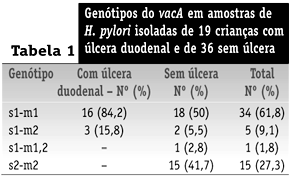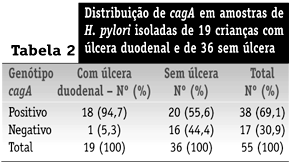Helicobacter pylori is now accepted as the most important agent of gastritis in humans and as a risk factor for ulcer disease and gastric carcinoma ethiopathogenesis. The outcome of the infection is associated with several factors, among them bacterial ones such as cagA and vacA s1 genotype. We aimed to investigate the association between cagA and vacA genotypes in H. pylori strains isolated from children and to correlate these findings with patient's disease. A total of 65 children (24 with duodenal ulcer and 41 without gastric or duodenal ulcer) were included in the study. CagA and vacA alleles were identified by PCR in bacterium strains isolated from the gastric mucosa of the studied group. Multiple-strain infection was detected in 10 (15.4%) patients. Among children with nonmixed infection, s1 allele was found in H. pylori strains isolated from 40 (72.7%), and m1 allele in strains obtained from 34 (61.8%). CagA was found in bacterium strains isolated from 38 (69.1%) patients. Association between cagA and s1-m1 genotype (p = 10-7), and between these genotypes and duodenal ulcer (p = 0.073 and p = 0.037, respectively) was observed. In conclusion, multiple-strain infection is frequent in Brazilian children. H. pylori strains harbouring, simultaneously, cagA and vacA s1-m1 genotypes are the most frequent in our pediatric population and are associated to ulcer disease.
H. pylori; vacA; cagA; Duodenal ulcer; Gastritis



